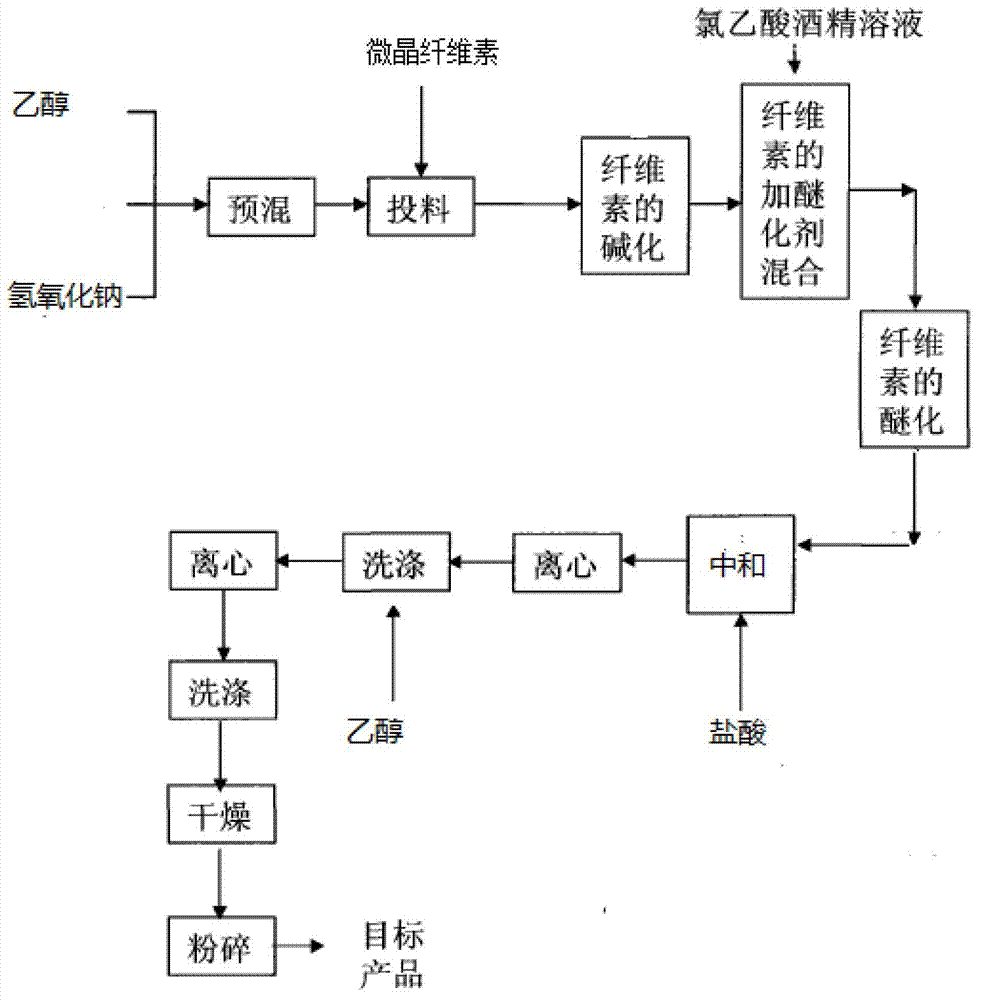Method for preparing low-viscosity sodium carboxymethylcellulose
A technology of sodium carboxymethyl cellulose and low viscosity, which is applied in the field of preparation of sodium carboxymethyl cellulose with low viscosity, can solve the problems of inability to achieve ultra-low viscosity, high viscosity, limitation of sodium carboxymethyl cellulose and the like, To achieve the effect of easy operation and ultra-low product viscosity
- Summary
- Abstract
- Description
- Claims
- Application Information
AI Technical Summary
Problems solved by technology
Method used
Image
Examples
preparation example Construction
[0015] see figure 1 . The preparation method of the low-viscosity sodium carboxymethyl cellulose described in this specific embodiment uses microcrystalline cellulose as a cellulose raw material, comprising the following steps:
[0016] 1) Premixing: pre-mix a certain amount of sodium hydroxide solution with a weight concentration of 45-52% and an ethanol solution with a weight concentration of 86-96% in a mixing container at a weight ratio of 1:1-3, and cool to 10-30°C.
[0017] 2) Feeding: Add the premixed sodium hydroxide ethanol solution into a kneader with a pair of "S" shaped shafts that rotate in opposite directions along the axis, and then add microcrystalline cellulose, microcrystalline fiber The polymerization degree of prime is 100-250. The weight ratio of microcrystalline cellulose to sodium hydroxide is controlled at 1:1-3, and the weight ratio of microcrystalline cellulose to ethanol solution is 1:1.2-5.
[0018] 3) Alkalinization of cellulose: the r...
Embodiment 1
[0026] In advance, mix 1.6 parts of sodium hydroxide solution with a weight concentration of 48% and 2.5 parts of an ethanol solution with a weight concentration of 90% and cool it below 25°C, add it to the reactor, and then add 1 part of microcrystalline cellulose to alkalize React for 40-80 minutes, alkalization temperature 15-40°C, add 1.2 parts of chloroacetic acid solution with a weight concentration of 65-78% after alkalization, etherify for 40-70 minutes, etherification temperature 25-50°C. After adding chloroacetic acid, raise the temperature to 75-80°C and continue etherification for 40-80 minutes. After etherification, discharge and neutralize the pH to 7.0-8.5, then wash and refine, recover ethanol, dry, pulverize, and sieve Produce ultra-low viscosity sodium carboxymethyl cellulose products. Viscosity (15% aqueous solution) 291mpa s, viscosity (30% aqueous solution) 16500mpa s, degree of substitution 0.962, purity 92.34%.
[0027]
Embodiment example 2
[0029] Mix 1.7 parts of sodium hydroxide solution with a weight concentration of 50% and 2.4 parts of an ethanol solution with a weight concentration of 92% in advance and cool it to below 25°C, add it to the reactor, and then put in 1 part of microcrystalline cellulose to alkalize Reaction for 40-80 minutes, alkalization temperature 15-40°C, after alkalization, add 1.3 parts of chloroacetic acid solution with a weight concentration of 65-78%, etherification for 40-70 minutes, etherification temperature 25-50°C. After adding chloroacetic acid, raise the temperature to 75-80°C and continue etherification for 40-80 minutes. After etherification, discharge and neutralize the pH to 7.0-8.5, then wash and refine, recover ethanol, dry, pulverize, and sieve Produce ultra-low viscosity sodium carboxymethyl cellulose products. Viscosity (15% aqueous solution) 283mpa s, viscosity (30% aqueous solution) 14750mpa s, degree of substitution 0.971, purity 91.76%.
[0030]
PUM
| Property | Measurement | Unit |
|---|---|---|
| viscosity | aaaaa | aaaaa |
| viscosity | aaaaa | aaaaa |
| viscosity | aaaaa | aaaaa |
Abstract
Description
Claims
Application Information
 Login to view more
Login to view more - R&D Engineer
- R&D Manager
- IP Professional
- Industry Leading Data Capabilities
- Powerful AI technology
- Patent DNA Extraction
Browse by: Latest US Patents, China's latest patents, Technical Efficacy Thesaurus, Application Domain, Technology Topic.
© 2024 PatSnap. All rights reserved.Legal|Privacy policy|Modern Slavery Act Transparency Statement|Sitemap

